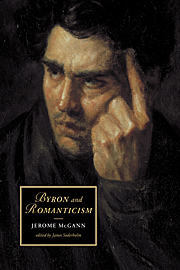Book contents
- Frontmatter
- Contents
- Acknowledgments
- General analytical and historical introduction
- PART I
- 1 Milton and Byron
- 2 Byron, mobility, and the poetics of historical ventriloquism
- 3 “My brain is feminine”: Byron and the poetry of deception
- 4 What difference do the circumstances of publication make to the interpretation of a literary work?
- 5 Byron and the anonymous lyric
- 6 Private poetry, public deception
- 7 Hero with a thousand faces: the rhetoric of Byronism
- 8 Byron and the lyric of sensibility
- 9 Byron and Wordsworth
- PART II
- Subject index
- Authors index
- CAMBRIDGE STUDIES IN ROMANTICISM
5 - Byron and the anonymous lyric
Published online by Cambridge University Press: 22 September 2009
- Frontmatter
- Contents
- Acknowledgments
- General analytical and historical introduction
- PART I
- 1 Milton and Byron
- 2 Byron, mobility, and the poetics of historical ventriloquism
- 3 “My brain is feminine”: Byron and the poetry of deception
- 4 What difference do the circumstances of publication make to the interpretation of a literary work?
- 5 Byron and the anonymous lyric
- 6 Private poetry, public deception
- 7 Hero with a thousand faces: the rhetoric of Byronism
- 8 Byron and the lyric of sensibility
- 9 Byron and Wordsworth
- PART II
- Subject index
- Authors index
- CAMBRIDGE STUDIES IN ROMANTICISM
Summary
Although academic criticism in the twentieth century has maintained a studied disinterest in Byron's lyric poetry, nineteenth-century attitudes were (as usual) very different. The difference is manifest in Pushkin, Heine, and Poe, but it takes its most startling and perhaps most significant form in Baudelaire. A key figure in the history of the lyric even for those (for instance, T. S. Eliot) who denigrated Byron's importance, Baudelaire took Byron's work as a crucial point of artistic departure. In that (now largely ignored) context the conventional academic view of Byron has to be judged, simply and objectively, mistaken. Profoundly mistaken.
To explain the historical contradiction involved here would require a revisionary critique of the modernist reception of Baudelaire. My object is more simple. I want to sketch certain key points of relation between Byron and Baudelaire in order to describe the general formal character of Byron's lyric procedures. Such a study will also display the peculiar subjectivity of Byron's narrative and dramatic poetry, and hence the remarkable transformation that he worked upon a paradigmatic Romantic form, the lyrical ballad.
The connection between Byron and Baudelaire is most easily traced through the cultural history of dandyism. To study Byron in that context, however, can easily obscure the technical issues to be understood when we try to recover what nineteenth-century writers found so important in Byron's lyrical procedures. So far as poetry as such is concerned, dandyism is important for the rhetorical postures it involves.
- Type
- Chapter
- Information
- Byron and Romanticism , pp. 93 - 112Publisher: Cambridge University PressPrint publication year: 2002
- 4
- Cited by

